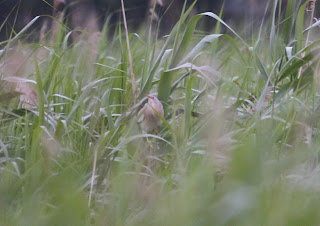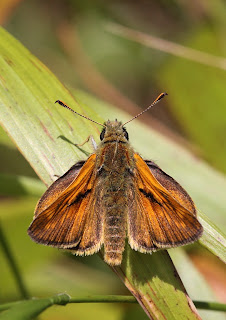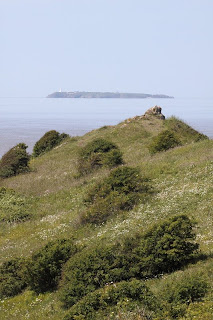This was the question asked by a rather baffled colleague when I happened to mention on Friday that I couldn't decide whether to get up at 2am and drive to Somerset, or go the evening before and sleep in the car.... and then that I was planning to continue to Cornwall.
The twitchery types among you will have read the first couple of lines, and knowingly thought: "Aha... he's trying to see the Little Bittern at Walton Heath. An elusive species best seen at dawn and dusk - good plan". The rest will have knowingly thought: "Dave's barking mad!" or probably something even less printable.
Probably both right. Never mind - I had a great time, though!
So, I eventually selected option B: left at about 9, encountered various tedious stretches of overnight roadworks, dug out a rather old CD featuring
this sort of thing to help keep me awake (yes, terrible, I know), and finally was nodding off to sleep in the Ashcott Corner carpark by just after midnight.
By 4.30 I was on the move, wandering through the dawn chorus along the old railway line towards Walton Heath, and then onto the Loxton Marsh Loop trail. Just after 5 I started hearing the hoped-for 'wuff' calls from the south end of the marsh, and almost immediately located the Little Bittern calling in the top of the reeds. No-one else there at this stage, a great experience justifying the rather antisocial hour! Obviously, the following photos are of a low standard due to the low light conditions at 5am, and not in any way related to the incompetence of the photographer....


Over the course of the next hour the bird was calling almost constantly, and a few more people turned up, some of whom had been wandering around unaware of what LB sounded like... Now, I'm not expecting every birder in the world to know every single call inside out, but if you were travelling to see a skulking bird which had been calling for a few days, it seems pretty sensible (to me, at least) to learn that call before you go. You might actually be able to find and (heaven forbid) identify it, all by yourself! Also you don't get to look such a kingsize prat when you ask "Any sign of the Little Bittern?" and someone says "Err, yeah - it's calling just over there, right now, and has been for the last 15 minutes". [Sorry, rant over...]
By 6.30, the LB had gone quiet and essentially stopped showing (note to other would-be Bittern twitchers... don't bother going during the day, unless you like sitting around staring at a very large reedbed for 9 hours), so I wandered back to the car for breakfast and to plot my next move. Bumped into Mike, the ever friendly
Gloster Birder, on the way - hope you had a good day.
Just down the road at Collard Hill, near Street, my targets were Large Blues. These are one of the rarest butterflies in the UK, having been reintroduced after going extinct nationally in the late 70's. Orchids were also very much in evidence - I think these two are Pyramidal and Common Spotted respectively, but please add a comment or let me know if I'm horribly wrong! A few Bee Orchids were even more spectacular, but I somehow neglected to get a decent photo, so you'll have to wait til another day for those.


I ended up seeing about 10-12 Large Blue, mostly low down on the south facing slope, and all very reluctant to pose with open wings. The underwing is still rather smart though, and this isn't a bad record shot. I also saw a couple of Marbled Whites, which always feel like they should be rarer than they really are... fantastic looking creatures.

Next stop was a rather optimistic trip to Sand Point near Weston-super-mare, where I hoped one or two late Glanville Fritillaries would still be on the wing. Unsurprisingly, it wasn't to be, but the scenery out over the Bristol Channel towards Flat Holm and Steep Holm wasn't too shabby, and some rather obliging Speckled Woods and Large Skippers were Canon fodder.



After a hearty and delicious meal - OK, I lied, a McDonalds - I headed on down the M5 to Exeter and on towards Bodmin Moor. A brief detour to avoid a closure of the A30 was no problem, and I reached Colliford Lake to find a rather depressed group of birders near Dozmary Pool. Again, this wasn't a massive surprise, since a) the reservoir is pretty distant, b) we were looking into the sun, and c) the Black Duck was showing really, really badly. Mostly c) was caused by a) and b), but also because it was constantly either out of view, or asleep, or both. Excellent. There's a Black Duck in this photo, directly underneath the farm on the hillside - honest.

Still, this was the reason I'd planned to make a decent weekend out of the trip... Black Duck was a lifer for me, so I wanted to see it, but since it's widely held to be one of the least inspiring rarities in the UK, I also wanted to make sure I saw a load of other bits and bobs in the process.
I finished the day booking in to the
YHA hostel in Golant, just outside Fowey on the south Cornish coast - somewhere I'd never been before, but would like to visit again with more time. Fowey's tiny streets and picturesque setting by the estuary are picture postcard stuff, and the hostel (complete with Skinner's on tap) was ideal - £15 a night can't be bad.
Running out of time now, so more to come tomorrow.... just time for an ID question - what are these flowers, photographed at Sand Point?























